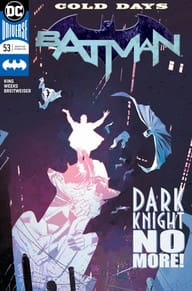The World’s Greatest Detective. The Dark Knight. Under that cowl, the suit of armor is a man. Batman has always been not only Gotham’s symbol of hope, but Bruce Wayne’s method to face his emotional battles in an indirect way. Especially right now. After suffering heartbreak and being sequestered away from fighting crime, we continue to see a man wrestling with the concept of who he is.
Batman #53 sees writer Tom King take us through a journey through Bruce’s current psyche in a room full of his fellow jurors as they deliberate on the verdict of Victor Fries. An important conversation stems from Bruce asking Missy, a fellow juror about their belief in God.
From there, Lee Weeks’ artwork takes us through the memories of Bruce’s beginnings. There are beautiful cuts of Batman fighting villains such as Two-Face and The Penguin. Even in the beginning, showing a younger Bruce Wayne kneeling towards his murdered parents where the frame takes a crimson red tone.
Bruce lost his “faith” with losing his parents. On his journey to becoming Batman, he found something new. It was becoming something that was bigger than any man could be. It’s Bruce’s own method of “transcendence” that he speaks of.
There’s a brief mention of the bible story of Job. Bruce Wayne has lost his parents, some friends, and the woman that he loves. It’s interesting that Bruce is not referring to God himself in this. He’s referring to Batman. His alter ego.
It’s a connection from his younger self asking God why he would take away his parents and Batman not being able to take his enduring pain away. Bruce Wayne views himself as Job. Now, within this court room, he’s not able to be Batman and you can see that it’s wearing on him.
This ropes back around to the jury and them being able to decide the fate of one man. Whereas God may be all knowing and all being, Batman is not. He’s not perfect at all. Batman lost control and with his fit of rage, almost killed Victor Fries.
There’s a bigger narrative of Bruce’s free will and that he tried to be in love and it broke him. He has to right this wrong in order to find what he thinks his ultimate fate should be – being the Batman. That’s why the final frame of the comic of Bruce in the classic suit is so important.
The cover by Elizabeth Breitweister sees Bruce Wayne discarding this instance of Batman. A temporary life that allowed himself to briefly dabble in thinking that he could have a normal life. King’s story highlights the struggles of Bruce Wayne in a way where you do feel sorry for him. It’s a life that won’t let him go, that constantly gets decided for him, and one that he needs.


